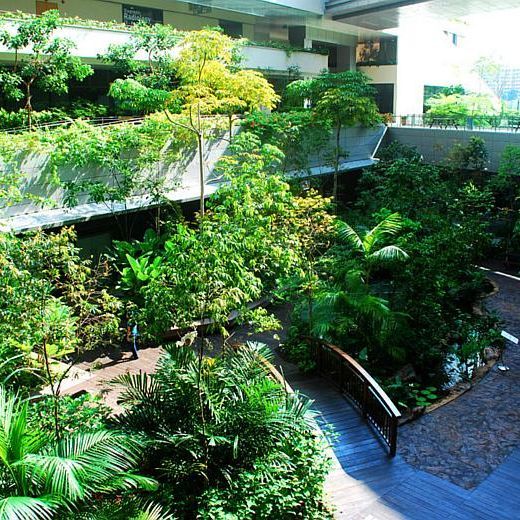
27/01/2020
WHY WE SHOULD ADDRESS WELLNESS IN THE BUILT ENVIRONMENT AND IMPLEMENT BIOPHILIC DESIGN STRATEGIES
The US Environmental Protection Agency ranks indoor environments as one of the top 5 risks to human health that we face today.
Biophilia describes the instinctive bond between human beings and other living things – Nature nurtures, calms and inspires us. Over a decade of research indicates that nature contact has a restorative effect on people, helping them deal with day-to-day stress and maintain their work performance. The challenge of biophilic design is to address the prevailing deficiencies of contemporary buildings by implementing strategies to include the beneficial experience of nature within the built environment (Kellert et al 2008, Kellert 2012, Kellert and Finnegan 2011).
The last decade has seen a steady growth in work around and the intersections of neuroscience and architecture, both in research and in practice; even green building standards have begun to incorporate biophilia, predominantly for its contribution to indoor environmental quality and connection to place.
Interface Flooring have produced a very comprehensive report - HUMAN SPACES: The Global Impact of Biophilic Design in the Workplace”- based upon a survey of 7,600 employees across 126 countries. Findings indicate that the top five elements most desired by employees in their working environment are natural light (44%), indoor plants (20%), view of the sea (17%), bright colours (15%) and quiet working space (19%). However, 47% of subjects had no access to natural light and 58% no access to plants. The report also concludes that access to nature including sunlight and plants boosted employee wellbeing by 15% and productivity by 6%.
KEY REPORT FINDINGS
- Biophilic design in the workplace has a strong, measurable impact on key employee outcomes such as well-being, productivity, creativity.
- Those who work in environments with natural elements, such as greenery and sunlight, report a 15% higher level of well-being than those who work in environments devoid of nature.
- Those who work in environments with natural elements, such as greenery and sunlight, report a 6% higher level of productivity than those who do not have the same connection to nature within their workspace.
- Those who work in environments with natural elements, such as greenery and sunlight, report a 15% higher level of creativity than those with no connection to natural elements in the workplace.
- Across the world, a third of all respondents report that the design of an office would affect their decision to work for that organization, presenting biophilic design as an important consideration for those companies that want to attract and recruit the best employees.
- Given its positive impact, surprisingly large numbers of employees reported having little or no contact with nature in their workplace – 47% report having no natural light in their workplace and 58% report having no natural greenery (live plants).
- The research shows that when people enter a workplace that incorporates nature, they are more likely to feel happy and motivated for the day ahead.
Other global studies have also reported similar findings as follows:
- Subjects who took a 40 second break to look out of a window at a green roof demonstrated higher concentration levels (6%) than those who had a view of a concrete roof (decreased concentration levels of 8%).
- Employees with the views of trees and landscape (north and west) took an average of 57 hours of sick leave per year, compared with 68 hours per year of sick leave taken by employees with no view. (Elzeyadi, 2011).
- The numbers of calls handled per hour by employees with seated access to views of vegetation through large windows from their cubicles far surpassed the number of calls handled per hour by employees with no view of the outdoors.
- They were 6-7% faster (Heschong, 2003c). Shifting workstations (to allow for views) cost about $1,000 per occupant but resulted in a 6% increase in call processing capacity, or about a $3,000 return per occupant.
- In hospitals, over fifty studies have been published that associate biophilic elements as primary influences for faster recovery rates for patients, decreased dependency on medication, reduced staff and family stress, and improved emotional wellness as a result of natural daylighting and views to nature. On average, patients whose windows overlooked a scene of nature were released after 7.96 days, compared with the 8.71 days for those who did not have a nature view (Ulrich, 1984)
- In schools, students in classrooms with the most daylighting tested 7-18% higher than those with the least (CA school district). Furthermore these students also demonstrated a 20-26% faster learning rate (Heschong, 1999).
- In a 1996 US study on student performance in daylit schools attendance was found to increase 3.2-3.8 days per year compared with attendance at non-daylit schools.
In addition, if one takes the corporate bottom line into account, the US Department of Labour (2010) showed average corporate office space costs as follows:
- 90.3% People
- 8.9% Rent/Mortgage
- 0.8% Energy costs
The Green movement is a 5 Trillion dollar industry (reducing energy, waste etc) and relates to only 0.8% of operational costs. Biophilic design relates to 90.3%! Considering that a 6% increase in productivity has been shown for those working in environments which incorporate nature, employers and designers alike are presented with an important opportunity to address productivity that can be easier to implement than traditional strategies.
In the US, Biophilic design and Wellness initiatives are already being implemented:
- It is generally expected in USA that 99% employers will offer some sort of wellness programme within next 1-4 years. Johnson + Johnson have demonstrated ROI of $2.71 for every $1 spent (2002 to 2008) with voluntary turnover rates of only 4% as a result of wellness initiatives.
- 50% of US employers with 50+ employees (which equals approx. 75% of US workforce) offer wellness promotion initiatives. 49% say health and productivity programmes are essential to company strategy. 91% offer programmes for reasons beyond medical cost savings. (Retention initiatives).
- 88 of the fortune 100 companies are Leed certified and have a wellness strategy in place.
- The American Society of Interior Designers (ASID) examined work processes and the impacts of their new WELL certified office space on their employees' behaviour and performance through pre-occupancy and post-occupancy surveys. They reported:
- 9% increase in collaborative work among staff.
- 25% of employees attributed circadian lighting at the new office for their enhanced sleep quality.
On the other hand, the main causes for deficient productivity tend to include absenteeism, loss of focus, negative mood, and poor health. Stress is the most common reason for long term absence among office personnel – in UK and Ireland findings indicate that stress accounts for 47% of short-term absence and 53% of long-term absence. According to Sainsbury Centre (UK) for mental health 40% of the time the typical worker takes off each year is due to mental health related issues.
The Sick Leave Statistics for the Public Service (Ireland) based upon over 265,000 Full-Time Equivalents (FTEs) across the public service and include the Civil Service and the Education, Health, Justice, Local Government, and Defence sectors, reveals the following data for 2017:
- The rate of sick leave across the service is 4.0%;
- The number of days lost to sick leave per FTE is 8.8 days
- The total cost of sick leave across the public service is estimated at €341.5 million.
Whilst the built environment is not always the cause of these stressors, when well-designed, can be a reliever of mental, emotional and physical symptoms. Thus Biophilic design can also provide a complementary strategy for addressing workplace stress and other familiar challenges to health and overall well-being.
Biophilic office environments also help to attract talent. Adare Human Resource management estimates costs of an average €13,100 to replace an employee. 260 organisations were surveyed (46,000 employees) - average staff turnover rate of 11%; average time to recruit replacement: 6 weeks. Millenials change jobs on average within 3 years.
In conclusion, the case to implement Biophilic design strategies within the workplace is very compelling and been shown to yield a high return on investment. However, designing for Health and Wellbeing should also be given proper consideration for all types of projects – residential, care, hospitality.
Image courtesy of www.straitstimes.com
